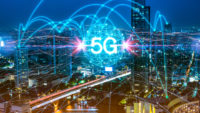How 5G Will Impact Transportation, Surgery, Factories, VR
December 20, 2019
Industry experts have recently been tantalizing consumers with the super-fast speed and zero latency of 5G networks. But to achieve the kind of coverage they depict will require as many as 20 access points per square kilometer — an expensive proposition. Consumers will have to get used to the idea that 5G will roll out, but not in an evenly distributed manner. Autonomous vehicles, Internet-assisted surgery, factory automation and virtual reality are some of the first sectors that will see the impact of 5G networks.
Wired reports that, although developers are “itching for 5G connectivity” to make cars autonomous, “way more exciting, if we’re talking real 5G, is not replacing human drivers but completely rethinking the way cars drive.” Instead, it suggests, imagine cars moving “like schools of fish, in unison, smoothly and tightly, without colliding” while swapping “data on location, speed, and heading.” It notes that, in 2017, “UC Berkeley researchers sent a trio of connected semi-trucks down a highway with just 60 to 140 feet between them,” and found that “such convoys could improve fuel efficiency by letting vehicles draft each other.”

Surgeons are also looking to 5G to “make Internet surgery a routine option.” Boston-based startup Corindus Vascular Robotics built CorPath, a robot, that performed five successful remote angioplasties; the company was acquired by Siemens Healthineers for $1.1 billion. Telesurgery wasn’t really possible earlier, but “Internet connections are now looking reliable enough.” An angioplasty in Gujarat, India was performed with a fiber-optic link, and, in the U.S., the company “is testing surgeries over 5G mobile networks.”
Factories also benefit from 5G’s abilities. At Foxconn’s factory in Shenzhen, China, there are assembly lines with few humans, and “behind all the automation is a tsunami of data.” Every detail of the machines’ behavior and performance is sent to 5G transmitters, which, says Wired, “promises to spark a revolution in productivity.”
Foxconn is adding more automation, and “faster, more powerful wireless tech will help choreograph the increasingly complex dance between robots and human workers.” Eventually, Apple engineers in California could monitor iPhone production in Foxconn’s assembly lines, “allowing them to make tweaks to boost output or fix a defect in minutes instead of days.”
Virtual reality will radically change once 5G comes online: “headsets that look back at you and reproduce your face in bits; real-world environments digitized in real time so users miles apart can share the same space.” With the ability to download data “at speeds more than 100 times faster than your current phone, wireless headsets will be able to render VR representations that look exactly like you, doppelgängers that vault across the uncanny valley and ape your features and tics as you talk.”
Augmented reality, predicts Wired, “will finally leap past ‘Pokémon Go’ and ‘Minecraft Earth’ to become a ubiquitous, useful infrastructure.”

No Comments Yet
You can be the first to comment!
Sorry, comments for this entry are closed at this time.